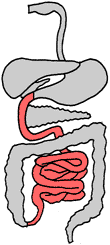 small intestine
small intestine
 C o o l ! M o r e
C o o l ! M o r e
S m a l l
i n t e s t i n e i n f o !
s m a l l i n t e s t i n e
Now back to this aborbtion thing we were talkin' about...
Most absorption occurs in the duodenum and jejeunum (second third of the
small intestine). Here the inner surface of the intestine has folds that
triple the surface area for absorption. Moreover, villi covered with
epithelial cells increase the surface area by another factor of ten. The
epithelial cells are lined with microvilli that further increase the
surface area; a 6 meter long tube has a surface area of 300 square meters.

![]() The main carbohydrates present in the small intestine are maltose,
sucrose, and lactose, which are absorbed by the microvilli. Starch is
broken down into two-glucose units (maltose) elsewhere. The disaccharides
are converted into monosaccharides by the enzymes in the cells, which then
leave the cell and enter the capillary. If there is a genetic lack of the
enzyme lactase produced by the intestinal cells, lactose intolerance will
result.
The main carbohydrates present in the small intestine are maltose,
sucrose, and lactose, which are absorbed by the microvilli. Starch is
broken down into two-glucose units (maltose) elsewhere. The disaccharides
are converted into monosaccharides by the enzymes in the cells, which then
leave the cell and enter the capillary. If there is a genetic lack of the
enzyme lactase produced by the intestinal cells, lactose intolerance will
result.
![]() Peptide fragments and amino acids cross the epithelial cell membranes
by active transport, and inside the cell they are broken into amino acids
which then enter the capillary.
Peptide fragments and amino acids cross the epithelial cell membranes
by active transport, and inside the cell they are broken into amino acids
which then enter the capillary.
![]() Digested fats are not very soluble. Fat digestion is usually completed
by the time the food reaches the ileum. In the ileum bile salts are
absorbed and are recycled by the liver and gall bladder. Fats pass from
the epithelial cells to the small lymph vessel that runs through the villus.
Digested fats are not very soluble. Fat digestion is usually completed
by the time the food reaches the ileum. In the ileum bile salts are
absorbed and are recycled by the liver and gall bladder. Fats pass from
the epithelial cells to the small lymph vessel that runs through the villus.
s m a l l i n t e s t i n e q u i z
![]() Test your knowledge on the small intestine. Click on next to start the quiz, or move
on to the next section to skip the quiz.
Test your knowledge on the small intestine. Click on next to start the quiz, or move
on to the next section to skip the quiz.
back to top